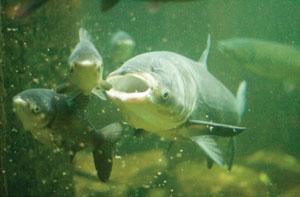(Provided by MDNR)
 No Bighead or Silver Carp Detected In Michigan's WatersThe Michigan DNR announced that so far in 2016, no bighead and silver carp environmental DNA (eDNA) has been found in Michigan waters.
No Bighead or Silver Carp Detected In Michigan's WatersThe Michigan DNR announced that so far in 2016, no bighead and silver carp environmental DNA (eDNA) has been found in Michigan waters.
The eDNA surveillance program ñ a collaborative effort between the Great Lakes states and the U.S. Fish and Wildlife Service (USFWS) - samples high priority locations for the presence of bighead and silver carp genetic material.
Since 2013, the DNR has partnered with the USFWS to implement a portion of the eDNA surveillance program in major tributaries to all the Great Lakes except Lake Superior, because it has been deemed very low-risk for introduction. This year, more than 2,445 samples will be collected, bringing the total from the last three years to approximately 7,200 water samples collected and analyzed. The majority of samples are taken from Lake Michigan tributaries such as the St. Joseph, Kalamazoo, Grand and Muskegon rivers.
Of the 2016 samples collected and analyzed, The DNR is still waiting for results from the third and final round of sampling in the St. Joseph, Grand, Kalamazoo, Muskegon, Macatawa, Galien and Black rivers. The final results are expected soon, but all other samples analyzed have come back negative at this point.
ìAlong with our participation in the eDNA surveillance program, we continue to be diligent with early detection efforts, such as conducting fish population surveys, increasing awareness among anglers, and maintaining an invasive carps reporting website for anglers to share any suspicious catches or observations that occur during their outings,î said Seth Herbst, the Fisheries Divisionís aquatic invasive species coordinator.
During the course of these sampling efforts, a single eDNA sample tested positive for silver carp genetic material in the Kalamazoo River in 2014. Based on further testing and work on the river, it was unlikely that the single detection out of 1,850 samples in 2014 was associated with a live fish.
ìA more likely explanation for that positive sample was a contamination source, such as visiting boaters or anglers from an area where silver carp is already established,î said Nick Popoff, manager of the DNRís Aquatic Species and Regulatory Affairs.
Results from eDNA testing conducted by the USFWS and its partner agencies throughout the Great Lakes basin can be viewed at: https://www.fws.gov/midwest/fisheries/eDNA.html.
For more information on invasive carp, visit Michigan.gov/invasives.


